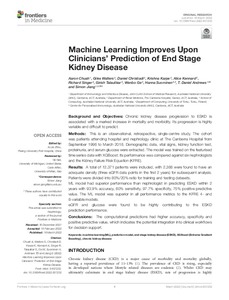Machine Learning Improves Upon Clinicians' Prediction of End Stage Kidney Disease
Talaulikar Girish; Christiadi Daniel; Walters Giles; Kennard Alice; Suominen Hanna; Ge Wenbo; Singer Richard; Jiang Simon; Karpe Krishna; Andrews T Daniel; Chuah Aaron
https://urn.fi/URN:NBN:fi-fe2022081154485
Tiivistelmä
Background and Objectives
Chronic kidney disease progression to ESKD is associated with a marked increase in mortality and morbidity. Its progression is highly variable and difficult to predict.
Methods
This is an observational, retrospective, single-centre study. The cohort was patients attending hospital and nephrology clinic at The Canberra Hospital from September 1996 to March 2018. Demographic data, vital signs, kidney function test, proteinuria, and serum glucose were extracted. The model was trained on the featurised time series data with XGBoost. Its performance was compared against six nephrologists and the Kidney Failure Risk Equation (KFRE).
Results
A total of 12,371 patients were included, with 2,388 were found to have an adequate density (three eGFR data points in the first 2 years) for subsequent analysis. Patients were divided into 80%/20% ratio for training and testing datasets.ML model had superior performance than nephrologist in predicting ESKD within 2 years with 93.9% accuracy, 60% sensitivity, 97.7% specificity, 75% positive predictive value. The ML model was superior in all performance metrics to the KFRE 4- and 8-variable models.eGFR and glucose were found to be highly contributing to the ESKD prediction performance.
Conclusions
The computational predictions had higher accuracy, specificity and positive predictive value, which indicates the potential integration into clinical workflows for decision support.
Kokoelmat
- Rinnakkaistallenteet [19207]
